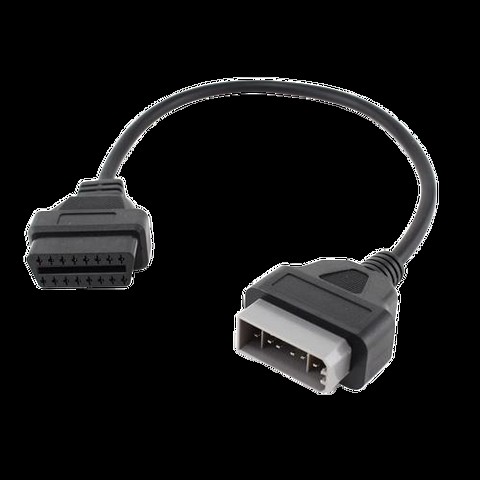As a car owner or automotive technician, you’ve likely encountered the terms OBD1 and OBD2. These refer to different generations of On-Board Diagnostics systems in vehicles, crucial for diagnosing and troubleshooting car problems. A common question arises when dealing with older vehicles: Can Obd2 Read Obd1 systems? This article, brought to you by carparteu.com’s auto repair experts, will delve into this topic, providing a comprehensive understanding of OBD compatibility and diagnostic tools.
Understanding OBD1 and OBD2: A Diagnostic Evolution
To answer the question of OBD2 and OBD1 compatibility, it’s essential to first understand what each system represents and how they differ.
OBD1 (On-Board Diagnostics Generation 1): This was the early generation of vehicle diagnostic systems, used predominantly in cars manufactured before the mid-1990s. However, some vehicles continued using OBD1 systems even up to the early 2000s. OBD1 systems were manufacturer-specific, meaning there was no standardization in terms of diagnostic connectors, communication protocols, or trouble codes. Each car manufacturer often had its own unique diagnostic setup.
OBD2 (On-Board Diagnostics Generation 2): Introduced in the mid-1990s and mandated in the USA for all cars manufactured from 1996 onwards, OBD2 brought standardization to vehicle diagnostics. OBD2 systems feature a standard 16-pin diagnostic connector, a standardized set of diagnostic trouble codes (DTCs), and common communication protocols. This standardization made vehicle diagnostics more accessible and user-friendly.
Can OBD2 Scan Tools Read OBD1? The Compatibility Question
Now, let’s directly address the core question: can OBD2 scan tools read OBD1 systems? The straightforward answer is no, generally, OBD2 scan tools cannot directly read OBD1 systems. Here’s why:
- Different Communication Protocols: OBD1 and OBD2 systems use different communication protocols. OBD2 scanners are designed to communicate using the standardized protocols established for OBD2. OBD1 systems, lacking this standardization, operate on various manufacturer-specific protocols that OBD2 scanners are not equipped to understand.
- Connector Differences: While some later OBD1 systems might use a 16-pin connector that physically resembles the OBD2 port, the pinout and communication methods are still OBD1. Older OBD1 systems often use completely different connectors, with varying pin counts and shapes.
Therefore, attempting to use a standard OBD2 scanner on an OBD1 vehicle will typically result in a communication error or no response at all. The OBD2 scanner simply isn’t designed to interpret the signals from an OBD1 system.
Adapters and OBD1 Compatibility: Clearing Up Confusion
You might encounter OBD adapter cables that seem to convert OBD1 ports to OBD2-style connectors. While these adapters physically allow you to connect an OBD2 scan tool to an OBD1 port, they do not magically make an OBD1 system readable by a standard OBD2 scanner.
These adapters primarily serve to adapt the physical connector shape and pinout. They do not bridge the gap in communication protocols. Think of it like a language barrier: an adapter is like a physical plug adapter for different electrical sockets – it doesn’t translate languages. Similarly, it doesn’t translate the diagnostic language from OBD1 to OBD2.
Key takeaway: An adapter alone does not enable an OBD2 scanner to read OBD1.
OBD1 Compatible Scan Tools: What You Need for Older Vehicles
To diagnose OBD1 vehicles, you need a scan tool specifically designed to be compatible with OBD1 protocols. These specialized tools are engineered to understand the diverse range of manufacturer-specific protocols used in OBD1 systems.
Often, these OBD1-compatible scan tools are also backward-compatible with OBD2. This means a tool designed for OBD1 will typically also be able to diagnose OBD2 vehicles. Investing in an OBD1/OBD2 compatible scan tool provides versatility, allowing you to work on both older and newer vehicles.
Identifying Your Vehicle’s Diagnostic System: OBD1 or OBD2
Determining whether your vehicle uses OBD1 or OBD2 is crucial before attempting any diagnostic procedures. Here are some guidelines:
- Manufacturing Year: Generally, vehicles manufactured in 1996 or later are OBD2 compliant, especially in the US market. However, some manufacturers started transitioning to OBD2 earlier. Vehicles from 1995 and earlier are usually OBD1.
- Check the OBD Port: OBD2 ports are typically located under the dashboard on the driver’s side and are a standard 16-pin trapezoidal shape.
OBD1 port locations and shapes are less standardized. They can be found under the dash, in the engine bay, or even in the center console. OBD1 connectors can vary in shape and pin count, often being round or rectangular and not always 16-pin.- Vehicle Manual: Your vehicle’s owner’s manual can provide information about its diagnostic system.
- Online Car Compatibility Lists: Resources like premium-diagnostics.com.au’s OBD2 car list (as mentioned in the original article) can be helpful in determining OBD compatibility for specific makes and models.
Important Note: Be cautious as some vehicles, particularly those from the transition years (early to mid-1990s), might have a 16-pin OBD-like connector but still operate on an OBD1 protocol. An OBD2 scanner will not work on these vehicles despite the connector appearance.
Conclusion: Choosing the Right Scan Tool for OBD1 and OBD2
In summary, OBD2 scan tools are not capable of reading OBD1 systems due to fundamental differences in communication protocols and system architecture. While adapters can physically connect OBD2 tools to OBD1 ports, they do not bridge the communication gap.
For diagnosing OBD1 vehicles, you need a dedicated OBD1-compatible scan tool. These tools often offer the added benefit of OBD2 compatibility, making them a versatile choice for workshops or enthusiasts working on a range of vehicles. Always verify your vehicle’s OBD type before selecting a scan tool to ensure proper diagnosis and avoid compatibility issues. Understanding the nuances of OBD1 and OBD2 is crucial for effective vehicle diagnostics and repair.
